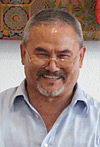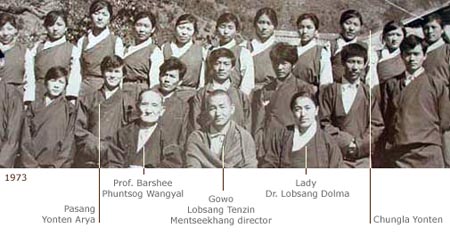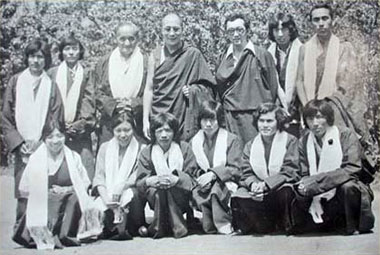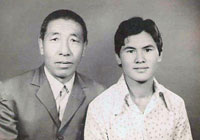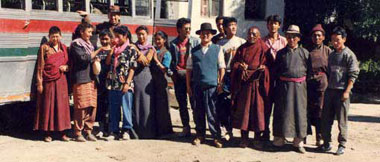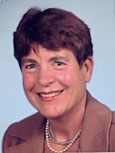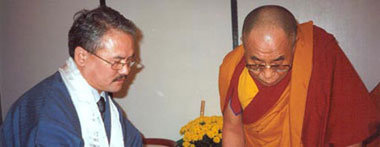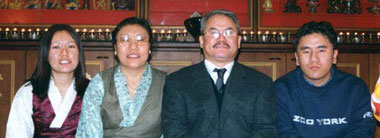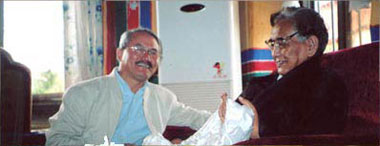Dr Pasang Y. Arya
Prof. Pasang Y. Arya is a prominent senior and experienced Tibetan doctor as well as a recognized teacher. Born in Tibet, he has graduated in Tibetan Medicine, Pharmacology and Tibetan Astrology, at the Tibetan Astro-medical Institute (Men-tsee-khang) of Dharamsala, India. He was a director and professor of Tibetan Medicine at the Men-tsee-khang Tibetan medical college and has been teaching Tibetan Medicine since 1983.
He regularly participates in national and international leading conferences in Tibetan Medicine in Europe, U.S.A. and Asia. He's been living in the West since 1992, and teaches Tibetan Medicine in Italy, Germany and Switzerland. Throughout these years, he has gained a long experience to share and explain the Traditional Tibetan concepts to a western audience.
Pasang Yonten Arya T. Sherpa's autobiography
Born as a farmer’s son
I was born in 1955, in a small village in Kyirong, Tibet - near the border of Nepal - in a family called Arya. There are today very few remaining families from the ancient Arya lineage who live in Tibet, Nepal and India. My ancestors were descendants of a very renowned tantric practitioner family of the 8th century in Tibet, and one of them was famous Khulungpa Yonten Gyatsho, the master of Yogi Milarepa for tantric storm magic.
He lived in Khulung, the village in the upper north part of Tibet where he left magic marks on the mountains and images on the rocks. His descendants later spread down to the Kyirong valley and also to Nepal. The Arya name has several meanings: holy, superior, and caste. The interpretation of core caste is also “lopon,” master, and “guru” in Tibetan and Tamang ethnic language in Nepal, and it is believed that the ancestors came from India or other surrounding countries. My late Uncle Paldhen Gyalop wrote down a story of our ancestor’s migration; it is still in my private library. My region, Kyirong, is a very beautiful valley in Tibet thanks to its dense forest, chains of snowy mountains and milky rivers. Many wild animals live peacefully there, since hunting and slaughtering are forbidden, as we can also find medicinal plants and flowers, see untouched landscapes, and monasteries in ruin in the Dolpo Mountains. In my small beautiful village and other Kyirong valleys as well as in the Nepalese countryside, it rains heavily in summer and snows a lot in winter. In spring and autumn, it is like Heaven on Earth. The region is called the Switzerland of Tibet.
A wounded child
My karmic connection with Tibetan medicine began when I burned my feet by fire when I was about two and a half years old and had no choice but to lay in bed for more than a year. I think I was in a coma during this painful period of my life and I've totally forgotten it. My late mother often told me the story of how I woke up one day from this long illness. It was a very cold winter day and my mother was trying to wake me up by showing me the big tree in front of our house. Its white branches were all bent by the weight of the snow and the many wild birds that had found shelter from the cold were singing altogether. Suddenly I awoke and said to my mother "Look, there are birds!"
With time, I was cured by a Tibetan doctor who was advised by the great master Venerable Palbar Geshe Rimpoche Lungtog Nyima, the master of the Kyirong people. Of course, my beloved parents also took care of me. My mother told me that she, my father and I went down to the Kyrong city searching for the Tibetan doctor, who had many children and a big family. He gave us some yellow powder medicine and advised that it should be mixed with “old butter” (one year old butter is useful in many disorders according to Tibetan Medicine) and used to massage from the neck to the feet (back side). They did so and after a few months I began to stand up straight.
I have some memory of that time: A long “menthang” (printed “om mani padme hum” mantra on stones) and us reaching the monastery of the great Lama. He called me, I accepted his call and received his blessing. I can still remember very clearly that on his right was a Mani wheel turning (Mani wheel is a Buddhist ritual of reciting and turning wheel of mantras. The wheel is filled with blessed mantras.). He took some water from a recipient placed below it and gave it to me. I drank it without any fear. He told my parents “the child will be alright. You should go back to Kyirong town and get some medicine from the doctor.”
Then I grew up like any other child, helping my parents until I was ten years old, even though I saw the Chinese cultural revolutions and their destruction.
Refugee in Nepal
The compassion of H.H. the Dalai Lama embodies the perfect quality of Buddha and there is no distance between the Potala and my tiny village in Kyirong district. The power of his love and compassion gave my family and me the strength to overcome danger and succeed in escaping to Nepal in 1965. I was ten years old and carrying the strict minimum with me. My late mother Tenzin Dolma, my little sister and I all crossed the dangerous mountain roads of Rasuwa Ghiri at the Tibet-Nepal border with the great fear that Chinese soldiers and civil officers would stop or chase us. But fortunately, no one came after us. My late father, uncle, and brother Tashi were waiting for us at the border. I was too young to feel sad or unhappy at the moment we crossed the bridge, but I remember thinking we had arrived at a strange and tiny village; it all looked so different. We went to our friend's house, also a refugee, and had lunch. Then, we, and our uncle's family went to stay near the hot thermal water for a month. We later found a house in the Nepali Tamang village called Sethang. I stayed there three years, growing up completely free, like a wild animal. I started my education in 1968 in a refugee camp school in Shabru Bensi, Rasuwa Jilla, Nepal. There, I met my enlightened master Geshe Gowo Lobsang Tenzin. He trained me in formal education and Buddhist spirituality inspired by the difficulties of refugee life. As I was naturally suited and intelligent enough to learn any subject fast, my master thought I could be a special person. He gave me the additional name “Yonten”. “Yonten” means "knowledge" or "positive quality".
In Dharamsala to study Tibetan Medicine
Under my master’s guidance I went to the Tibetan Medical Institute, Dharamsala- India, to study Tibetan Medicine and other sciences. There, I met my new masters Prof. Barshee Phuntsog Wangyel, Dr. Jamyang Tashi and Lady Dr. Lobsang Dolma. I studied Medicine, Astrology and all other Tibetan sciences without any difficulty. If it is not presumptuous, I may add that these teachings were possibly connected to my previous life. I thus continued my studies and gained experiences. I received many spiritual teachings from different Tibetan masters and mainly from H.H. the Dalai Lama.
After my graduation in Medicine and Astrology in 1977, the Tibetan Medical and Astrology Institute selected my friend Namgyal Tsering and me to study pharmacology. The aim of these studies was, and still is, to perpetuate the secret tradition of Tibetan pharmacology of Dr. Jamyang Tashi, personal physician of H.H. the Dalai Lama who had originally practiced at the Lhasa Mentseekhang.
I served as an assistant pharmacologist in this same Institute until 1982. That same year, the Institute appointed me as teacher, and from 1984 to 1989 as professor and Principal of the Medical College.
In 1989 I went to Leh, Ladakh, and taught for three years Tibetan Medicine in the "School of Buddhist philosophy". This period was the most constructive in my life as I met prominent Tibetan Buddhist practitioners and scholars from whom I received practical teachings of tantras and Naropa’s six yoga practices. With my wife Dr. Chungla Yonten Arya running the Yuthok clinic at Choklamsar, life was in its highest harmony and peace with spiritual experiences and liberation. At that time, our interest was also oriented towards the West, to learn about the people and their civilizations. This exchange of knowledge between the East and the West was another kind of journey that we wanted to make.
In 1991, I began my first journey to the West. It all started in the Soviet Union, as I was a member of the exiled Tibetan government’s delegation for the Soviet Union and Mongolia. It was a long visit and I gained a lot of experience through my contacts with Western cultures. Next, I went to Canada for some medicine seminars and workshops. In 1992, Tibetan Lama Healer Gangchen Rimpoche of Milano invited me in Italy, and I took part in his project on Tibetan Medicine until 1997. During these years I also worked in Germany, Switzerland, Spain and France and visited Austria and other European countries for conferences, seminars and Tibetan Medicine workshops. I found it to be a great experience to learn the different life styles and psychology of Westerners.1994 was the year I began to settle down in Italy and bring my family and children. I worked with other Western doctors on research and consultation. My learning of the Occident and my teaching then increased as more and more people around me became interested. I thus organized the "East and West seminar on Tibetan Medicine" with the Mentseekhang in Dharamsala in 1996. About 40 Western scholars, doctors and hundreds of Tibetan doctors participated in the seminar.
In 1998, I left the Lama Gangchen Center and began to work on my own in Milan-Italy, Germany, as well as other countries.
The New Yuthok Institute for Tibetan Medicine
I realized then that the creation of a school for Tibetan Medicine was very important to responsive Tibetans and Westerners. It could indeed fill the demands for studying and researching the culture and science of the Tibetan people. Therefore I founded "The New Yuthok Institute for Tibetan Medicine" in Milan, Italy in 1999. There, Westerners can learn in their mother tongue the Tibetan art of healing “gSowa Rigpa,” Buddhist psychology, and other sciences. The Institute organizes Tibetan Medicine, Buddhist Psychology, and Tibetan Astrology courses, special seminars, as well as cultural, language and spiritual retreats, among other topics.* *
Dr. med. Walburg Maric´ Oehler
Dr. med. Walburg Maric´ Oehler visited Ladakh in 1990. We met there in our Ladakhi styled rented house and clinic, along with her daughter Sonja Maric’. We exchanged our interest and both found a common ground in the deep and profound study of the art of Medicine that still exists and keeps a spiritual and cultural soul, and has thus not yet been transformed into technical medicine. That is what can be found in Tibetan Medicine even now. Later Dr. Walburg Maric´ Oehler invited me to her praxis for the first time in 1993 in Bad Homburg, Germany, and gave a two-day lecture on Tibetan Medicine. I was then mentally prepared but technically very behind with what Western medical professionals demonstrated in seminars. The development of the methodology was a great experience for me, along with the presentation of Tibetan Medicine. I borrowed the Western way of presentation and language of interpretation with technical methodology.
Dr. Walburg Maric´ Oehler, President of the “German Medical Acupuncture Association” DÄGfA, has made tireless efforts to promote Tibetan Medicine and has worked hard, beside her profession, on its development in Germany through the DÄGfA and the Institut für Ost-West Medizin. We succeeded in introducing Tibetan Medicine like any other complementary medicine systems at the Natural Medicine Congress in Germany. The DÄGfA invited me as a guest professor and I began the first course in 1993.
We have struggled greatly and shared the difficulties during these years without losing our courage, and created the course in Freudenstadt, Baden-Baden, Bad Homburg and Bad Neuheim successfully. Since 1993, there is a constant growing interest and demand from German doctors to follow the introduction course and receive the diploma at the end of the training.
Experience in the West
The introduction of Tibetan Medicine to Western medical doctors is not so simple for many reasons. First of all, many Western doctors, naturopaths, pharmacists, herbalists, healers, who are interested in Tibetan Medicine, search for some simple techniques of treatment for certain disorders, or some Tibetan magical cure, rather than go through a deep study. Some dwell too much on fantasy and thus expect to see some miracle cures. There are also many people, full of sympathy, good wishes and interest in Buddhism and Tibetan culture.
The introduction of Tibetan Medicine and its philosophy in the West is like a crude diamond that needs to be modified according to culture and life style. An old Tibetan proverb says, “A pure diamond, to become a valuable object, definitely needs to be purified by the diamond cutter and polisher”. But it isn't so easy to realize this because of the previously said Western fantasizing and sympathy towards the Tibetans, and its mixed attitude of fear and interest towards oriental cultures. However Tibetan Medicine needs and will find its place in the West, to develop and exchange the sciences through a scientific language and approach.
Dream and favorite interest
Since adolescence, my great wish has been to become a scholar and writer. I think it was my teachers who influenced me because I have always admired scholars. Therefore I naturally have great enthusiasm in reading and writing in the fields of history, natural sciences, human psychology and philosophy.
Beside the academic line, I have a lot of pleasure discovering new vista and landscapes. I love the white Christmas festival most because the snow and trees remind me of my tiny beautiful village in Tibet with its treasure of dense forest during the winter.
Academic work
So far I have written several books on interested subjects. However because of the lack of publisher and financial difficulties some of my books were lost. Below are some of the books written in Tibetan language, most still not translated in other languages.
Dr. Chungla Yonten Arya
Dr. Chungla Yonten was born in Sakya in 1955 in the family of Menkyid Khangsar, and is a descendant of Chamdatsang, a noble family of Sakya, Tibet. She escaped with her late brothers to India in 1963 and received a formal education in the central Tibetan schools Panchmari and Dalhousie. She joined the Tibetan Medical Institute in 1973 to study Medicine and graduated in 1977. She then worked as a resident doctor at the Medical institute until 1991.
We are married and have two children, Donyod Dolma Arya and Tenzin Tsangyang Arya.
Back to Tibet In 2004, after 40 years abroad, we saw our motherland again, Tibet, a wide country, open on a deep blue sky adorned with white marble like clouds. Serene and pure feeling winds that refresh the mind blow there. Lhasa has however more or less turned into a modern city. The first day of our arrival, according to the tradition, we went to salute and pay homage to the holy Jokhang temple where the historical Buddha Shakyamuni statue is located, and prayed with joy and emotion. A Tibetan man sitting next to me, watched me carefully and said "this foreigner makes good prostrations"…
As our family is made of Tibetan physicians, we went to Lhasa mentseekhang and visited the museum where the old medicine grindstone of Yuthok Yonten Gonpo, among other medical instruments, is preserved. Then we got the chance to see Dr. Jampa Thrinley (ex-director of Lhasa Mentseekhang), the leader of the preservation and propagation of Tibetan Medicine and Astrology, even during the "cultural revolution" and after. He is a man of gentle character, soft speaking and well nourished by the Buddhist practice. He is retired now and lives in his master Khyenrab Norbu's (founder of Mentseekhang in 1916) quarter. He has lost his eyes but still can see through his mind. He helped us get to the birth place of elder Yuthok Yonten Gonpo, the "father of Tibetan Medicine" in Toelung.
Publications
1. Dictionary of Tibetan Materia Medica
This dictionary may be one of the first books in the history of the Materia Medica of Tibetan Medicine. It is written in traditional Tibetan style in alphabetical order. The book allows to easily find the synonyms and secret names used, for certain reasons, in Tibetan medical formulae and literatures by ancient scholars. It is translated into English with Latin botanical names by Dr. Yonten Gyatso. It also gives brief information about Materia Medica, literature resource and ingredients, classification of the species, identifications, taste, power, post-digestion, and uses. It is an very useful book for Tibetan readers and researchers, easy to search for Latin names in Tibetan alphabetical orders. But this book has a disadvantage for the westerners, as they have to find the terms through Tibetan alphabet. The author wishes to write in the future an easy index for the English western readers.
First edition:
The first edition was published in Tibetan in 1989
by New Yuthok Institute, Leh Ladakh, India.
(out of print)
Second edition:
It was translated in English by Dr. Yonten Gyatso and published by Motilal Banarsi Dass, India (www.mlbd.com) in 1998.
ISBN:81-208-1567-x
Third edition:
It was published by Scherzverlag of München in 2001
in German and translated by Thomas Dunkenberger.
The translator added extra traditional synonyms of the ingredients and made an index in German alphabetical order.
2. History of Tibetan Medicine past and present
This is the author’s favorite and first book written after many years of research in Tibetan Medical history. It has some special works done on Tibetan Bon Medicine, researched in the history of Tibetan Medicine and Greco-Arabian medicine, and traces the steps of the development of Tibetan Medicine in the eastern province of Kham, Amdo, and the western Himalaya of the Indian states. It also covers the development of Tibetan Medicine in Mongolia, Bhutan, Nepal and modern western countries. Especially it collects the chronology of prominent Tibetan physicians of the past and gives detailed information of the later part of the historical development from the 17th to the 20th century.
First edition:
Published in Tibetan by the author in 1989 and winner of the prize of “Best academic and cultural book of the year 1989” from Jammu-Kashmir state, India.
(out of print)
It is still not translated yet into other languages.
3. Common illnesses and their cures in Tibetan Medicine
This is a small practical manual booklet written during the author’s three years work in Leh, Ladakh. It is useful for the beginners in Tibetan Medicine and very useful for the people living in the remote areas where there are no trained Tibetan physicians available. It describes a simple way of diagnosis and treatment for common diseases. The treatments specially show how to treat the common disease by diet, behavior and simple herbal preparations and therapies.
It is currently translated in Italian for the Tibetan Medicine students.
First edition:
In Tibetan and published by the author.
(out of print)
There are other books on different subjects to be published in the near future and numerous articles published in national and international journals and publications.
Pasang Yonten Arya's curriculum vitae
1955
1966
- Escaped to Nepal during the Cultural Revolution under the Chinese invasion in Tibet.
1968
- Admitted to formal education at a refugee school of Shabru Bensi, Rasuwa district, Nepal, under the guidance of Master Geshe Gowo Lobsang Tenzin.
1973
- Joint the Mentseekhang, Dharamsala, India. Studied Tibetan medicine, Tibetan astrology, traditional Tibetan Buddhist philosophy and secular sciences.
1977
- Graduation in Tibetan medicine and astrology.
- Specialization in Tibetan Pharmacology for three years.
1980
- Assistant director in the pharmaceutical department of the Mentseekhang.
1982
- Participation in the team led by Dr. Tenzin Choedrak, personal physician of H.H. the Dalai Lama, and learning of the traditional Tibetan Pharmacology on mercury purification and precious stones and metal detoxification works for three months in Dharamsala.
1983
- Lecturer in Tibetan medicine at the Tibetan medical school of Mentseekhang.
1985-89
- Principal/director of the medical school of Mentseekhang and professor in Tibetan medicine.
- Participation in the “Ladakhi Amchi system of medicine conference” organized by Amchi section for the “Save the children fund” of England.
1986
- Participation in the “National conference on five Buddhist sciences” at Lahul & Spiti region of Himachal Pradesh organized by the Ladakh Buddhist philosophy school.
1989
- Resignation from the Mentseekhang.
- Lecturer at the Buddhist philosophy school in Ladakh. Starting of a new section of Tibetan Medicine.
- Opening of the Yuthok clinic at Choklamsar, Leh Ladakh with Chungla Yonten.
1990
- Led an important group of over 50 students and senior ladakhi Amchis in a “medicinal herbs study and excursion” held from Kargyil to Zanskar Mountains organized by Amchi Tsewang sManla of the “Save the Children fund Amchi section”.
1991
- At the Tibetan exile-government’s invitation, visit with the exile-government’s good will delegation (nine members) to Soviet Union and Mongolia. Participation in the Asian Peace conference at Ulanbator, Mongolia.
- Participation in the “National conference on five Buddhist sciences” at Thekchen Choeling Temple in Dharamsala organized by the Ladakh Buddhist philosophy school. Presentation on “rtsa-rlung” to the assembly of Lamas, Tulkus, Geshes and Monks from Tibetan and Himalayan Buddhist Schools and traditions.
- Led the first Ladakhi Amchi students “Materia medica study and research tour “ to the down town cities of Amritsar and Delhi.
- Visit in Canada, and European tour for Tibetan medicine courses and conferences.
1992
- At the invitation of Lama Gangchen Center, start of Tibetan Medicine teaching in Italy.
- Resignation from the Ladakh Buddhist philosophy school
- Invitation from the German Medical Acupuncture society (Daegfa) as a Guest Docent in Tibetan medicine education for German post-graduate medical doctors program of 20 seminars with examination proceeding successfully until now.
1994
- Start of a three years Tibetan medicine course held in Merigar, Grossetto organized by Shangshung Institute, Italy.
- Participation in “La Médecine Tibetaine”, Exposion - Seminaire, Maison de Saint-Jean-Cour, Lausanne, Switzerland.
1996
- Organization of the “East-west seminar” held in Mentseekhang, Dharamsala, India, gathering 40 western people and over one hundred Tibetan physicians
1998
- Participation in the first international congress on Tibetan medicine organized by Pro-Cultura in Washington USA. Presentations on Rheumatism and Tibetan traditional diagnosis.
- Resignation from Lama Gangchen center
1999
- Started again a new life with the preparation of the independent “New Yuthok Institute for Tibetan medicine” Association for the study of Tibetan medicine and related Tibetan sciences.
- Set up and start of a four-year Tibetan medicine course, courses and seminars on Tibetan medicine, Astrology and Buddhist psychology, as well as conferences, in Italy and Europe.
2001
- Participation in the “Convegno nazionale “Dono e trasfusione”, contatto, scambio, e dialogo tra civilta d’Oriente e d’occidente” Venezia, Italy, organized by AVIS, Regione del Veneto, Comune di Veneto, Ambasciata Indiana.
2002
- Participation in the International Congress “Medizin Traditionen in Ost und West“ Graz, Austria. Presentation on “Buddhism and Tibetan medicine”.
2003
- Participation in the 2nd International Congress on Tibetan Medicine Washington, USA organized by Pro-Cultura. Presentations on Menopause and Tibetan & Bon Medicine.
- Start of a Three years Tibetan medicine course held in Bad Ragaz Switzerland organized by Ms. Jutta Padrun
- Started study groups of Tibetan materia medica and leading on herbal excursions in Switzerland, Austria, and Italian Alps.
- Long time taken initiative for the recognition of Tibetan medicine by Italian government finally recognized as a complementary medicine in Italy and entered in the list of natural medicine.
- Lecture on “Tibetan medicine” in European parliament Brussels organized by the intergroup of natural complimentary medicine Brussels.
2004
- Organized congress by New Yuthok Institute on “La medicina Tibetana, Integrazione di un’ antica guarigione nella scienza medica moderna” Roma.
- Number of special seminars begin to be organized every year on dream, Tibetan Medical psychiatry, Gynecology, Materia Medica, Herbs excursion, Padma products, Astrology and Buddhist psychology.
2005
- Participation as a key speaker in the Seminar-cum-workshop for education programs, Central Institute of Higher Tibetan Studies, Varanasi, India organized by the Central Council for Tibetan Medicine of H.H. the Dalai Lama, Dharamsala India
- Organization and leading of a seven-day Medicine Buddha retreat for students and practitioners. Teachings on Medicine Buddha, Tibetan tantric yoga and meditation practices. This retreat continues to take place every year.
- Foundation of “www.TibetanMedicine-Edu.org”, a virtual teaching center dedicated to the transmission of Tibetan medicine in the West.
- Lecture on Aging disease in Tibetan medicine in the “Mianzer Akupunktur-symposium, Gesund aelter werden, Akupunktur im dialog” organized by Daegfa and University Mainz, Germany.
2006
- Participation in the Tibetan Medicine Congress “Médecine tibétaine & Occident/The West and Tibetan medicine” in Geneva, Switzerland, Organized by the «Conservatoire des Savoirs Médicaux Traditionnels et Populaires». Presentations on Tibetan medicine & Buddhist psychology, and Tibetan traditional Medicine.
- Seminar «Bridge between Eastern and Western medicine” Netherland organized by tibetmedicine.nl. Presentation on “Tibetan medicine in Millennium”.
2007
- Start of the Khahudragzong Yogi house project to renovate yogi caves in Sakya region, Tibet.
- Tibetan medicine conference held at Turin University. Presentation on “Tibetan medicine and its philosophy”.
- Participation in the conference “Il cuore dei profughi tibetani” organized by Cardio Lab, Tibetan Delek Hospital, Associazione Italia-Tibet, Ordine dei medici chirurghi e degli odantoiatori della provincia della Rimini. Circolo della stampa Milano, Italy.
2008
- National Seminar-Cum-Workshop on Tibetan Medicine, Dharamsala, organized by the Central Council of Tibetan Medicine (CCTM) and the Tibetan Medical and Astrology Institute (TMAI). Presentations on “Tibetan Moxibustion practice”, “Chronic intestinal disorders” and “rtsa-rlung Thigle” Yoga Buddhist tantra.
- 15th Anniversary of Tibetan medical education for German doctors celebrated in the “Tibetan medicine Symposium” held in Bad Homburg Germany.
- 1st “Mindfullness e Ipnosi” workshop on Coscienza e Inconscio in Oriente e in Occidente, Capua, Italy
2009
- 2nd “Mindfullness e Ipnosi” Workshop, Capua, Italy
- 1st seminar on “Dream and Bardo” in Napoli, Italy.
- Lecture on Tibetan medicine in “Le medicine non-convenzionali corso di aggiornamento” organized by servizio formazione e aggiornamento, Napoli, Italy.
- Lecture on Tibetan Medicine in Hecv-Sante, Haute Ecole Cantonale Vaudoise de la santé, Lausanne Switzerland.
- Participation in the Astrology Congress “Convegno cieli e terre: armonie tra diversita’ e Unita” Perugia.
- 10th anniversary of new Yuthok Institute, Organization and participation in the Tibetan Medicine Congress "Spirituality and compassion as cure of the body and mind", organized by the New Yuthok Institute, Milan.
2010
- TME launches a three-year online course on Tibetan medicine in order to meet the demand of the interested people, promote, and propagate the Tibetan culture, Medicine and Buddhist psychology and related sciences.
